Note: This is a project under development. The articles on this wiki are just being initiated and broadly incomplete. You can Help creating new pages.
Peganum harmala
Peganum harmala, commonly called wild rue, Syrian rue, African rue, esfand, or harmel, (among other similar pronunciations and spellings), is a perennial, herbaceous plant, with a woody underground root-stock, of the family Nitrariaceae, usually growing in saline soils in temperate desert and Mediterranean regions.
Contents
- 1 Uses
- 2 Parts Used
- 3 Chemical Composition
- 4 Common names
- 5 Properties
- 6 Habit
- 7 Identification
- 8 List of Ayurvedic medicine in which the herb is used
- 9 Where to get the saplings
- 10 Mode of Propagation
- 11 How to plant/cultivate
- 12 Commonly seen growing in areas
- 13 Photo Gallery
- 14 References
- 15 External Links
Uses
Analgesic, Emmenagogue, Abortifacient agent, Anthelmintic
Parts Used
Chemical Composition
Peganum harmala L. smoke has been used traditionally in Middle Eastern and Asian countries as a disinfectant and air purifier. Here, the smoke was collected by a simple, reproducible method, and its chemical constituents of the smoke and volatile oil were analyzed. [1]
Common names
| Language | Common name |
|---|---|
| Kannada | |
| Hindi | |
| Malayalam | |
| Tamil | |
| Telugu | |
| Marathi | NA |
| Gujarathi | NA |
| Punjabi | NA |
| Kashmiri | NA |
| Sanskrit | |
| English | Wild rue, Syrian rue, African rue, Esfand, or Harmel |
Properties
Reference: Dravya - Substance, Rasa - Taste, Guna - Qualities, Veerya - Potency, Vipaka - Post-digesion effect, Karma - Pharmacological activity, Prabhava - Therepeutics.
Dravya
Rasa
Guna
Veerya
Vipaka
Karma
Prabhava
Habit
Identification
Leaf
| Kind | Shape | Feature |
|---|---|---|
| Simple | Lobes have smooth margins | 1.5–2.5 mm (0.06–0.10 in) long stipules at the base. The leaf blade is dissected/forked twice or more into three to five thin, linear to lanceolate-linear, greyish lobes. |
Flower
| Type | Size | Color and composition | Stamen | More information |
|---|---|---|---|---|
| Bisexual | Yellowish white, White | About 2–3 cm in diameter. Greenish veins are visible in the petals. They have a threadlike, 1.2 cm long pedicel. The flowers have five (10-)12–15(−20)mm long, linear, pointy-ended, glabrous, sepals, often divided into lobes, although often entire and sometimes only divided at the end. |
Fruit
| Type | Size | Mass | Appearance | Seeds | More information |
|---|---|---|---|---|---|
| Simple Fruit | Round | 6–10(−15) mm in diameter | Light brown | {{{6}}} |
Other features
List of Ayurvedic medicine in which the herb is used
Where to get the saplings
Mode of Propagation
How to plant/cultivate
Prefers a light well-drained but moisture retentive soil and an open position in full sun. Prefers a dry soil and succeeds in poor soils. Although this species comes from dry desert areas, it responds well to cultivation so long as the soil is very well drained. [3]
Commonly seen growing in areas
Photo Gallery
References
External Links
- Ayurvedic Herbs known to be helpful to treat Analgesic
- Ayurvedic Herbs known to be helpful to treat Emmenagogue
- Ayurvedic Herbs known to be helpful to treat Abortifacient agent
- Ayurvedic Herbs known to be helpful to treat Anthelmintic
- Herbs with Fruits used in medicine
- Herbs with common name in English
- Habit - Herbs
- Index of Plants which can be propagated by Seeds
- Herbs that are commonly seen in the region of Tropical region
- Herbs
- Nitrariaceae



